An Eight-Step Self-Study Course in German Genealogy Research![]()
Single booklet purchases and Full Course purchases are available options. All single booklets are $19.13. The Full Set is $106 a savings of $20. Shipping is included and Handling is applied at checkout.
VOLUME 1: BEGINNING GENEALOGY: START IT RIGHT! A BEGINNER COURSE BY ARTA F. JOHNSON, PH.D., 76 pgs., © 1993, 1994, 2017 Ohio Chapter Palatines to America, Columbus, OH spiral, softbound
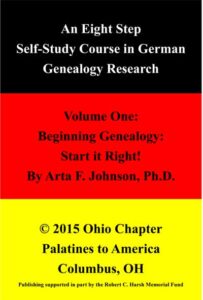 Begin at the very beginning; it’s a perfect place to start,” sang Maria to the Van Trapp children. And so it is –the beginning is the same place now as it was 20 years ago, or 40 years ago, or 100 years ago. Despite technological advances in the 21st century, the methodology, research techniques, recording, and citation requirements remain the same. This volume was designed as a three-hour course for a National Palatines to America Conference as a companion course to Kenneth Smith’s “The very basics of German Genealogy Research,,” which pays attention to the peculiarities of researching in German records. [Volume Two in the Series] Dr. Johnson doesn’t beat around the bush. She delivers straightforward and plain advice about beginning your genealogy research to build a sound foundation. Much of the research she did by
Begin at the very beginning; it’s a perfect place to start,” sang Maria to the Van Trapp children. And so it is –the beginning is the same place now as it was 20 years ago, or 40 years ago, or 100 years ago. Despite technological advances in the 21st century, the methodology, research techniques, recording, and citation requirements remain the same. This volume was designed as a three-hour course for a National Palatines to America Conference as a companion course to Kenneth Smith’s “The very basics of German Genealogy Research,,” which pays attention to the peculiarities of researching in German records. [Volume Two in the Series] Dr. Johnson doesn’t beat around the bush. She delivers straightforward and plain advice about beginning your genealogy research to build a sound foundation. Much of the research she did by
mail is now done by email, making it much easier and less time-consuming for 21st-century researchers. But the basics are still the same. The 2017 edition has been enhanced with an Exercise for every chapter to enable the reader to use what they have learned to further their family history research, with forms to use to begin to gather family information and with updates to reflect 21st-century technology, including updated bibliography and web-based resources, this volume is the best beginners course from one of the most avid, educated, and prolific genealogists of our time, and a dedicated member of PALAM. $15 plus Shipping and Handling.
Vol I in An Eight-Step Self-Study Course in German ResearchBUY NOW VOL. 1
VOLUME 2: THE VERY BASICS OF GERMAN GENEALOGICAL RESEARCH BY KENNETH L. SMITH 67 pages, © 1993, 2017 Ohio Chapter Palatines to America, Columbus, OH spiral, softbound
“Genealogical research is genealogical research” is how Mr. Smith opens this follow-up course to Dr. Johnson’s “Beginning Genealogy.”
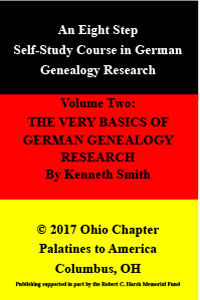
The purpose of this book is to help you research German ancestors. It will be assumed that you are familiar with basic genealogical research techniques such as record keeping, understanding what constitutes primary as opposed to secondary sources, etc. Here we will deal with the aspects that make German genealogical research different from other types. And Mr. Smith delivers on his promise, accompanied by case studies about proving the immigrant ancestor here and there, discussing research in modern-day Germany, and reference books essential to any German research. The 2017 edition has been enhanced with an Exercise for every chapter to enable the reader to use what they have learned to further their family history research, with forms to use to begin to gather family information and with updates to reflect 21st-century technology, including updated bibliography and web-based resources. This volume is the perfect next step to learning the ins and outs of German Genealogical Research. Mr. Smith was a section presenter at the 2014 National Palatines to America Conference and many Ohio Seminars. $15 plus Shipping and Handling
Vol 2 in An Eight-Step Self-Study Course in German ResearchBUY NOW VOL. 2
VOLUME 3: PEOPLE OF THE PALATINE BY ARTA F. JOHNSON, PH.D., 46 pages, © 1981, 1989, 2017 Ohio Chapter Palatines to America, Columbus, OH spiral, softbound

We are descended from these or people like these, and let us be proud of them: they did their best and survived. This is a sampling of what life was like for our ancestors. We would often like to know more…..sometimes they would have liked to know what happened. If you want a detailed history of the area we call the Palatinate, this is it, from the early 1600s to the mid-1800s. Dr. Johnson succinctly makes the perfect case for why we need to know the history of our ancestors to improve our research. Have you hit a brick wall? Perhaps your ancestor died during the Thirty Years War or the bubonic plague. Did your ancestors live during the French Revolution of 1685 – 1689? What effect did that have on our Palatine ancestors? Are you surprised by multiple marriages? Women frequently died in childbirth, and the fathers needed someone to raise their children. Knowing that life expectancy was 34 years in the 17th and 18th centuries leads us to know what years to research. A perfect follow-up to Mr. Smith’s overall look at German research, Dr. Johnson expertly describes life in the Palatine with information based on her own personal research and case studies from the lives of her ancestors. The 2017 edition has been enhanced with an Exercise for every chapter to enable the reader to use what they have learned to further their family history research, with forms to use to begin to gather family information and with updates to reflect 21st-century technology, including updated bibliography and web-based resources, this volume is the best beginners course from one of the most avid, educated, and prolific genealogists of our time, and a dedicated member of PALAM. $15 plus Shipping and Handling
Vol 3 in An Eight-Step Self-Study Course in German ResearchBUY NOW VOL. 3
VOLUME 4: THE ORIGINS, DEVELOPMENT, & MEANINGS OF GERMAN NAMES BY ARTA F. JOHNSON, PH.D., 78 pages, © 1984, 2017 Ohio Chapter Palatines to America, Columbus, OH spiral, softbound
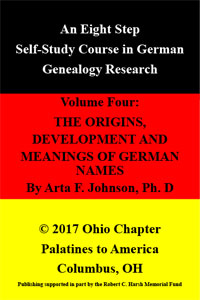
The earliest names in German lands were all of Germanic linguistic rootstock. With the coming of Christianity, a vast store of non-Germanic names became available. Catholic Bishops and parish priests urged the faithful to baptize their children with good “Christian” names. The faithful did not pay any attention. At the Council of Trent (1545-1563), the Church absolutely required the use of names of saints, martyrs, and angels in baptism.
If you do any research in German records, you will have to know about the naming traditions used both before and after the Council of Trent. Do you know what a calling name is? Do you know the difference between Johan and Johannes? Why are all the girls in your family named Maria? How do you tell them apart?
Dr. Johnson answers these questions and more in this essential reference which begins its discussion in pre-historic times. Included are lists of name meanings, nicknames, combined name forms, and a history of surnames.
The 2017 edition has been enhanced with an Exercise for every chapter to enable the reader to use what they have learned to further their family history research, with forms to use to begin to gather family information and with updates to reflect 21st-century technology, including updated bibliography and web-based resources, this volume is the best beginners course from one of the most avid, educated, and prolific genealogists of our time, and a dedicated member of PALAM. $15 plus Shipping and Handling.
Vol 4 The Germans & German NamesBUY NOW VOL. 4
VOLUME 5: A GUIDE TO THE SPELLING AND PRONUNCIATION OF GERMAN NAMES By ARTA F. JOHNSON, Ph. D, 85 pgs., © 1981, 2017, Ohio Chapter, Palatines to America, Columbus, OH, spiral softbound

This book is a “primer,” a place to begin for family researchers who have German ancestors but who have no knowledge of the German language. To deal competently with German names, the researcher needs some knowledge of the German language. Grammar and vocabulary are desirable if one is using old German records. But the indispensable tool for working with German names is a familiarity with the pronunciation of German and the spellings that represent the sounds.
This book first covers the sounds of German. It describes, as well as can be done without a tape recording or phonograph record, how letters and combinations of letters are pronounced in German. It will not solve all problems, but it will solve many of them, point the way for solving others, and show how to avoid common pitfalls. A short bibliography lists several helpful books.
The 2017 edition has been enhanced with an Exercise for every chapter to enable the reader to use what they have learned to further their family history research, with forms to use to begin to gather family information and with updates to reflect 21st-century technology, including updated bibliography and web-based resources, this volume is the best beginners course from one of the most avid, educated, and prolific genealogists of our time, and a dedicated member of PALAM. $15 plus Shipping and Handling
Vol 5 A Guide to the Spelling and Pronunciation of German NamesBUY NOW VOL. 5
VOLUME 6: HOW TO READ GERMAN CHURCH RECORDS WITHOUT KNOWING MUCH GERMAN By ARTA F. JOHNSON, Ph. D, 79 pages, © 1980, 2017 Ohio Chapter – Palatines to America, Columbus, OH spiral softbound
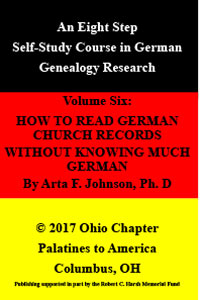
This booklet is a primer, a “beginner book,” designed for researchers who have no knowledge of the German language but would like to extract for themselves the information given in church records written in German, in this country, or in Europe. It is not intended to be a course in the German language; only the essential vocabulary and minimal grammar are given. This booklet is a place to start. It has just about everything needed by a beginner. The best feature is its ring binding, which allows it to lay flat while you are researching.
We search old records to find our ancestors: names and dates of births, marriages, and deaths. But church records were never meant to be vital statistics: they were (and are) records of the sacraments of the Church. We must remember this fact as we search old church records: much information we would like included is not necessarily there, and we should not expect it to be there. A baptismal record, for example, is the record of a sacrament, not a birth certificate.
The 2017 edition has been enhanced with an Exercise for every chapter to enable the reader to use what they have learned to further their family history research, with forms to use to begin to gather family information and with updates to reflect 21st-century technology, including updated bibliography and web-based resources, this volume is the best beginners course from one of the most avid, educated, and prolific genealogists of our time, and a dedicated member of PALAM. $15 plus Shipping and Handling
Vol 6 How to Read German Church Records Without Knowing Much GermanBUY NOW VOL. 6
VOLUME 7: MIGRATIONS WEST & BACKTRACKING EAST By MERLIN C. & EVA M. FINNELL AND ARTA F. JOHNSON, Ph.D., 54 pages, © 1984, 2017 Ohio Chapter Palatines to America, Columbus, OH spiral softbound

This book combines the work of Merlin and Eva Finnell, and Dr. Arta Johnson, all of Palatines to America. The first chapter and the map section are contributions of the Finnells, with the following three sections contributed by Dr. Johnson.
Our ancestor’s voyage to the New World did not end at the port; it continued into the heartland, mountains, valleys, deserts, and farmland throughout the country. Migration includes all of these moves, and maps help us visualize that movement.
Migration had its start at the very beginning of this country. They no sooner had settlers arrived in a particular locality than they felt the urge to move. New opportunities, cheaper or better land, gold, and the chance to improve one’s individual opportunities were all strong forces. Family ties and political or military influences also caused many to move on. The depletion of the soil and overpopulation also had their effects on migration. And just plain “adventure” lured some to the frontier country. Patterns of settlement and particular travel routes began to emerge from all this moving. The hand-drawn maps included will help the reader to see where they went and how they went.
The 2017 edition has been enhanced with an Exercise for every chapter to enable the reader to use what they have learned to further their family history research, with forms to use to begin to gather family information and with updates to reflect 21st-century technology, including updated bibliography and web-based resources. $15 plus Shipping and Handling
VOLUME 7: MIGRATIONS WEST & BACKTRACKING EASTBUY NOW VOL. 7
VOLUME 8: MIGRATIONS OF GERMAN-SPEAKING PEOPLE INTO AND OUT OF OHIO BEFORE 1850 By ERNEST THODE, 46 pages, © 1993, 2017 Ohio Chapter Palatines to America, Columbus, OH spiral, softbound
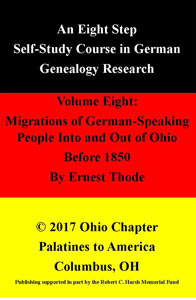
The theme of the book is “For Land’s Sake.” As with several other of the Volumes in this Self-Study series, this book began as a project in connection with the 1993 National Conference of the Palatines to America in Columbus, Ohio. Ernie Thode, a well-renowned genealogy expert, speaker, and writer, collected family migration histories or histories of Ohio German settlements from members of Palam. This resulting monograph covers the migration within the United States of ethnic Germans into Ohio and then out of Ohio in an attempt to show certain patterns and help genealogical backtracking. By 1850 people had started to move on from Ohio, too, so a picture begins to emerge of where Ohioans moved to from the figures available in the U.S. Federal Census of 1850, the first one to list birthplaces. The theme of the book is “For Land’s Sake.”
This volume may be of special interest to anyone attempting to prove the presence of their ancestors in Ohio during the state’s settlement and development before and after becoming a state on March 1, 1803. The clues may be found here if you attempt to prove their presence for application to a First Families lineage Society.
The 2017 edition has been enhanced with an Exercise for every chapter to enable the reader to use what they have learned to further their family history research, with forms to use to begin to gather family information and with updates to reflect 21st-century technology, including updated bibliography and web-based resources. $15 plus Shipping and Handling
Vol 8 Migrations of German-Speaking People Into and Out of Ohio before 1850 BUY NOW VOL. 8
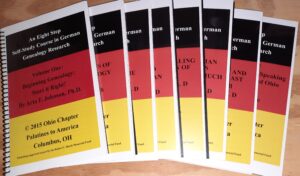
8 Vol. Complete Set of Self-Service German Research Guides $100 plus Shipping and Handling
8 Vol. Complete Set of Self-Service German Research Guides BUY NOW Complete Set
Nineteenth Century Emigrants from Baden-Wurttemberg By; Brigitte Burkett , CGRS 448pp.
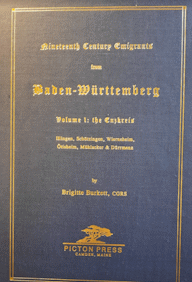
Two dozen photos & maps. Every Name Index includes ships and places. 1997 #1797 Fresh from the spectacular success of her similarly titled book on 18th-century immigrants from Baden-Württemberg, Brigitte Burkett has now compiled a similar book on immigrants of the 19th century. A stunning total of 976 families are documented here, a truly astounding feat! $27.00 + Shipping & Handling
Nineteenth Century Emigrants from Baden-Wurttemberg BUY NOW Burket
Eighteenth Century Emigrants from Langenselbold in Hesse to America By Annette Kunselman Burgert
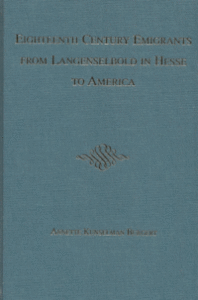 The emigration from Langenselbold and nearby villages in Germany started in 1709, when the first group left for England, arriving in New York in 1710. More than 70 families came directly to Pa., with a few arriving before 1727 when the ship passenger lists start. Some of the families include names such as Beck, Dressler, Eckert, Faust, Fischer, Hahn, Koch, Lamm, Leinbach, Lerch, Reber, Roth, etc. $24.00 + Shipping & Handling
The emigration from Langenselbold and nearby villages in Germany started in 1709, when the first group left for England, arriving in New York in 1710. More than 70 families came directly to Pa., with a few arriving before 1727 when the ship passenger lists start. Some of the families include names such as Beck, Dressler, Eckert, Faust, Fischer, Hahn, Koch, Lamm, Leinbach, Lerch, Reber, Roth, etc. $24.00 + Shipping & Handling
Eighteenth Century Emigrants from Langenselbold in Hesse to America BUY NOW Burgert